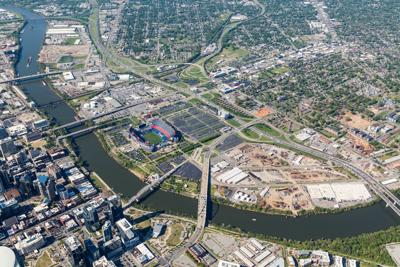This story is a partnership between the Nashville Banner and the Nashville Scene. The Banner is a nonprofit, nonpartisan news organization focused on civic news. For more information, visit NashvilleBanner.com.
A meeting of the Ad-Hoc East Bank Committee on Monday night offered the most detailed look yet at the future of the East Bank.
At 550 acres, the East Bank is a massive developmental undertaking, expected to take decades to complete. Currently an underdeveloped sea of concrete centrally located between the Cumberland River and I-24, the land has been a sore spot in Nashville for years as development grows around it. Intertwined with the success of Mayor John Cooper’s Titans stadium deal last year was his administration’s promise of an East Bank overhaul, turning it into Nashville’s new up-and-coming neighborhood, with a promise that it would not just be another tourist trap.
The East Bank is home to 110 acres of Metro-owned land. Thirty acres of that land has been selected as an “Initial Development Area” near the new stadium. On the final day of Cooper’s administration, the protest period for a contract with The Fallon Company to be the master developer of the 30-acre IDA ended. That means that negotiations had to begin almost immediately after Mayor Freddie O’Connell took office in September. In November, during the last meeting of the Ad-Hoc East Bank Committee, O’Connell’s chief development officer Bob Mendes told the committee that negotiations with Fallon were just getting underway, as the new administration had spent its first months in office getting their ducks in a row.
Two months later, the public has gotten its first look at how those negotiations are shaping up.
“The lawyer in me is making a giant disclaimer at the front end,” said Mendes at the start of Monday’s meeting. “We are doing something that, at least in my time in Metro government, I haven’t seen done before. And that is we’re giving a snapshot in time in the middle of a negotiation. When I gave the mayor a similar presentation 10 days ago, many of these slides were different because the negotiation has moved forward over the last 10 days.”
While Mendes stressed that negotiations are still ongoing and nothing is final, he indicated that many of the most impactful aspects of the development were all but set in stone outside of hammering out the details. Here are some of the highlights of the “snapshot” of negotiations:
With a new Titans stadium set to open in 2027, development will soon begin within the 338-acre plot
Affordable Housing
The lack of affordable housing is an ongoing crisis in Nashville, and advocates made it known that a lack of affordable housing on the East Bank would be unacceptable. Critics argued that such a centrally located plot of land would be a difficult spot for affordable housing when revenues are already such a problem.
Metro is currently in discussion with Fallon to set certain minimums on the number of housing units they will require to be developed in the IDA. While Mendes stressed that the numbers could change, he said he believes they will accomplish the following as negotiations go forward.
Of 1,550 total residential units, Mendes said the current breakdown would be:
- 855 market-rate units
- 600 affordable housing units split between two buildings that are 100% affordable housing
- 95 affordable housing units in market-rate buildings
- A minimum of five residential buildings
Mendes said the administration has gone into negotiations focusing on creating a neighborhood feel. A part of that has been setting milestones in the timeline for when construction of a number of residential units will begin, milestones Mendes said he is confident they won’t do worse than. Within two years of executing either the Master Development Agreement or the required rezoning, Fallon is expected to start construction on 300 residential units and one other building. Within six years, developers are expected to start a total of 700 residential units, and within 10 years that number will grow to 1,250.
Additionally, Fallon has already agreed to have those affordable units locked in as affordable for the entirety of their 99-year ground lease, a massive win for affordable housing advocates.
Tennessee Performing Arts Center
Mendes revealed on Monday that Metro has a tentative agreement with TPAC, which has long been rumored to be in search of a new home on the East Bank, to relocate to a riverfront parcel on the southern side of the IDA.
TPAC’s parcel will be excluded from the agreement with Fallon, as it will be negotiated directly between Metro and TPAC. The building’s design will be subject to approval by the Metro Planning Department.
As a part of the agreement, TPAC will also invest in some of the surrounding infrastructure, including the re-landing of the John Seigenthaler Pedestrian Bridge, which will be structurally attached to TPAC and will extend beyond the space to deposit pedestrians almost directly next to the stadium.
A presentation slide lays out early infrastructure projects that will need to take place in order for development to proceed. Total construction estimates take into account soft costs, contingencies and year of expenditure, providing a more accurate estimate.
Infrastructure and Costs
Metro will have to make some big upfront investments in the infrastructure of the East Bank, the full extent of which is not yet known. Aside from the infrastructure Metro itself has to pay for, Fallon, the Titans and TPAC will also be footing the bill for various infrastructure projects that will need to be completed for construction to move forward.
As part of the Titans stadium financing deal made last year, Metro agreed to provide the Titans with 2,000 parking spaces for dedicated stadium usage. Metro also agreed that the Titans would receive all revenue produced by parking on an event day.
The result is a $64 million parking garage that Metro will be responsible for constructing, accounting for about half of Metro’s infrastructure financial responsibilities in the IDA.
Another heavy lift for Metro will be a brand-new sewer pump station. Building a neighborhood out of nothing brings with it the problem of increased sewage. Legislation for the construction of that sewer pump station has already been filed and passed through the Budget and Finance Committee just before Monday’s meeting.
The sewage pump station will cost a total of $32.5 million, but the Titans will pay for 20 percent of that to account for the amount of waste the stadium will create. Mendes believes the rest of the money will be recouped over time through taxes on developments that are served by the station.
Zoning
In order to do any of these things, the zoning code for the East Bank will have to change. Of course, zoning also offers Metro an opportunity to limit the ways the East Bank could be used, preventing the dreaded “Lower Broadway II” that many Nashvillians are worried about.
Metro’s intention is to expand the downtown zoning code to the East Bank. The downtown code allows for strict control over how buildings are used and designed. The Metro Planning Department is proposing very specific land use requirements, which Metro Planning manager Joni Williams said will encourage “a mixed-use urban neighborhood.”
Those conditions would include the prohibition of industrial uses, strict parking limits, the prohibition of short-term rentals and restrictions on the number and proximity of bars.
Timeline
The East Bank development in its entirety will take decades. Mendes said he expects the development of the 30-acre IDA alone to span up to three two-term mayoral administrations.
Simply put, these negotiations are just the tip of the iceberg. Parcels A and B, on the northernmost portion of the IDA, are not even expected to be developed within the next 10 years.
On the legislative end of things, Mendes said a master development agreement with Fallon — a contract that would include details such as a timeline, what phases go first, a description of responsibilities, land usage, documents related to future lease agreements, and of course a price tag — should hit the Metro Council floor by early March. The administration’s hope is that it could then pass in April, kicking off the actual development process.
From there, the development will essentially emerge outward from the stadium, beginning on the southern side, and working its way towards the river over time, providing a mixture of residential, retail and hotel usage.
On Jan. 31, District 5 and 6 Metro Councilmembers Sean Parker and Clay Capp will hold a joint town hall meeting to discuss the East Bank.






